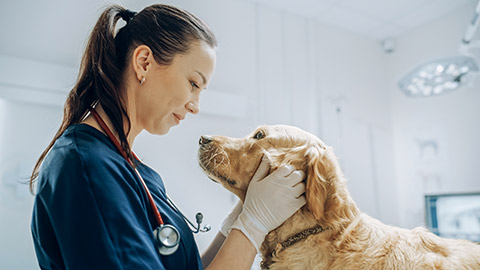Before we dive into the types of communication, it is important to understand that there is more to communication than back-and-forth verbal conversation. Several other components make up communication. Within the workplace, you will be required to communicate internally with colleagues, supervisors, and management. Externally, you will be required to liaise with customers, suppliers and possibly government departments. It is important to remember that effective communication skills can be learnt and practised, just like learning a musical instrument.
When working in the animal industry, you will be expected to communicate with people on a regular basis. You may be the first point of contact for clients; therefore, your communication skills and first impressions are very important.

There are various types of communication, including presentation styles, platforms, and formats, that can be used for communication, especially given we are living in a world that relies heavily on technology.
The following table illustrates the various types of communication and how they can be applied in the workplace. Take the time to familiarise yourself with each type before we look at them in further detail.
| Type of communication | How it is applied in the workplace |
|---|---|
| Face-to-face |
Used for:
|
| Telephone |
Used for:
|
|
Used for:
|
|
| Social media |
Used for:
|
| Written |
Used for:
|
Examples of Interactions
| Interactions | Types of Communication |
|---|---|
| Inquiries or instructions about products and services | - Phone Conversation - Information brochures - Emails or written forms of communications - Face-to-face communication |
| Collecting payments | - Face to face - Face to Face - Over the phone - Email correspondence - Written Correspondance |
| Advising clients of payment issues | - Email Correspondance - Face to Face - Written correspondence |

There is a lot to consider with face-to-face interaction because you are both seen and heard. The way you present yourself physically and verbally with your body, as well as your language and tone, will be very important factors.
There are times when you will have high-stress situations where you will have to think on your feet and act fast, so it is important to remain calm at all times. In the animal care industry, it is not uncommon to have difficult scenarios present at the most unexpected times. You must always be prepared where you can. For example, you may have someone who has called the practice/clinic to let you know of a dog that was just hit by a car. Upon hearing this, you should ideally start to prepare a certain recovery area in the clinic beforehand to eliminate any delays and possible stress factors of being ill-prepared. You may also need to triage the animals that you already have in the clinic; in this case, you will not be aware of the degree of injury the dog has sustained. Therefore you may need to escalate the treatment of this dog above some of the others who may be in for a simple vaccination.
Naturally, there are times you may find it stressful; one way of managing stressful situations is setting a goal or planning. This will help alleviate some of that burden or maybe even all of it.
Speaking Skills
The following are some tips that you should consider when engaging in face-to-face communication with colleagues, clients/ patients.
Eye contact
Not looking someone in the eye can be interpreted as being evasive and insecure. Be sure to make eye contact but try not to stare, remember to blink, and move your head every so often to break the contact momentarily.
Use correct industry terminology.
The use of slang words, nicknames or acronyms can be confusing to people outside the workplace or industry and can make you appear unprofessional. Always ensure the listener has understood any important directions or advice.
Suitable language
It is important to use language suitable for the listener’s age and experience, and remember, be flexible to your audience. The way you explain something to a ten-year-old child will differ from how you speak to an adult.
Correct grammar
Careless use of grammar can create a poor impression of both you and your business. Always make an effort to be accurate in grammar. For example, use “John and I” not “Me and John”.
The clear sequence of thoughts and ideas
People will always have difficulty understanding your spoken message if your thoughts are confused and your words are jumbled. The following examples differentiate between appropriate (Example A) and in-appropriate (Example B) sequence.
Example A
"Please ring to arrange an appointment with the vet; Friday mornings are usually the best time. Thursdays and Saturdays can be quite busy."
Example B
“Maybe if you… ah… come back when the vet is in… or… no, usually Thursday is a bad day… and Saturday is always busy… Friday morning is okay… and ring first to find out if he’s here.”
Active listening
When you are engaging in face-to-face communication with others, you need to show respect for your audience by listening attentively. It is particularly important during the early stages of your career when you are still learning and when you are dealing with clients. Your senior team members, such as those in management, are there to teach you fundamental aspects of the animal care industry. They are often highly trained and very experienced; therefore, they are an invaluable resource for you to turn to.
Effective listening can be the difference between following instructions correctly, building strong relationships with your colleagues, taking messages correctly and establishing your relationships with clients. Where interactions with clients are concerned, you must also be aware that, at times, clients may become quite distressed with concern over their pets and may be difficult to understand. This is where your active listening skills come into place.

To demonstrate you are actively listening, consider the following points.
- Acknowledge you are listening with a simple nod of your head, affirming you have heard what has been said.
- Make regular eye contact, but avoid staring.
- Refrain from interrupting when others are talking to you, wait for a moment where you may be able to interject.
- Display empathy; this is particularly important when dealing with distressed clients.
- Allow the speaker to explain their concerns and ask their questions.
- Reflect on what has been said and then provide an answer.
- Paraphrase if you require further clarification.
The following video emphasises the importance of active listening.
Case Study
Happy Paws Animal Care Facility
A family with two young children visits Happy Paws Animal Care to adopt a dog. They’ve seen a few dogs on the website and are excited but also a bit unsure about which dog would be the best fit for their home.
 |
Kristy (Receptionist): Smiling warmly as the family enters "Good afternoon! Welcome to Happy Paws Animal Care. How can I assist you today?" |
 |
Father: "Hi! We’re here to adopt a dog. We saw a few on the website that we liked, but we’re not sure which one would be best for our family." |
 |
Kristy: Maintaining eye contact and nodding "That’s wonderful! We’re so glad you’re considering adopting. If you don’t mind, I can ask you a few questions to help us find the perfect match for your family." |
 |
Mother: "Sure, that would be great." |
 |
Kristy: In a friendly tone "Can you tell me a bit about your home? Do you have a yard, and how much time do you think you’ll spend with your new dog each day?" |
 |
Father: "We have a decent-sized yard, and the kids are really excited to play with the dog. We’re all home most evenings, and we love going on weekend hikes." |
 |
Kristy: Kristy then leads the family to the dog kennels, pointing out the dogs she mentioned and giving a brief overview of each one’s temperament and needs. |
 |
Child: Excitedly "Oh, can we meet this one? He looks so happy!" |
 |
Kristy: Kristy arranges for the family to spend time with the dog in a safe, enclosed area, watching as they interact and answering any questions they might have. |
 |
Mother: After some time, turning to Kristy "He’s really sweet and seems to love the kids. What do you think, is he a good fit for us?" |
 |
Kristy: With a reassuring tone "He’s a great choice for an active family like yours. He loves attention and would enjoy all the playtime your kids can offer. Plus, his temperament is well-suited for young children. If you’re ready, we can start the adoption process." |
 |
Father: "Let’s do it!" |
 |
Kristy: The interaction continues with Kristy helping the family complete the adoption process, ensuring they leave Happy Paws Animal Care with confidence and excitement about their new furry family member. |

In addition to communication types, there are four communication styles. Communication styles refer to the tone, language and way people communicate. It is important, especially when you are working with people and their pets that you are aware of the tone and language you use when you are communicating. In these settings, you will find that heightened emotions often drive them, and the way you handle the situation can make all the difference.
Let us take the time to go through each of the communication styles in further detail.
Passive communication style
People who demonstrate a passive communication style often avoid expressing their feelings and/or opinions even though it fails to promote their needs and rights.
Characteristics demonstrated by people using the passive communication style include:
- allowing others to interrupt them when they try to speak
- allowing others to make decisions for them
- apologising even when they have done nothing wrong.
Aggressive communication style
People who demonstrate an aggressive communication style often express their feelings and/or opinions to promote their own needs even though it violates the rights of others.
Characteristics demonstrated by people using the aggressive communication style include:
- being very direct and excessively honest
- interrupting others when they try to speak
- speaking in a loud and demanding voice.
Passive-aggressive communication style
People who demonstrate a passive-aggressive communication style don’t express their feelings and/or opinions outright but do so in subtle and indirect ways, resulting in a failure to promote their own needs and the violation of the rights of others.
Characteristics demonstrated by people using the passive-aggressive communication style include:
- refusing to acknowledge their own anger
- stating their true feelings rudely towards the end of interactions
- using sarcasm to mask their true intentions.
Assertive communication style
People who demonstrate an assertive communication style directly express their feelings and/or opinions in a way that is considerate of those they are communicating with. They promote their own needs while still respecting the rights of others.
Characteristics demonstrated by people using the assertive communication style include:
- expressing disagreement respectfully
- stating their true needs and wants clearly and respectfully
- speaking with confidence.
Questions
Naturally, when starting out in any line of work for the first time, you will have an abundance of questions. Questions are a fantastic way to seek information from others, especially those who are more experienced. However, the types of questions you ask also play a role in the type of information you receive back; you must always consider the type of question you are asking before you ask it. The two main types of questions are closed and open-ended questions. Closed-ended questions require a single response with very minimal detail, while an open-ended question enables elaboration and specific details.
The following table illustrates some of the question types, an example of how they are used, and a response.
| Question | Type of question | Example |
|---|---|---|
| What | Closed-ended |
Question: What breed of dog is this? Answer: Dalmatian |
| Who | Closed-ended |
Question: Who is responsible for writing prescriptions Answer: The veterinarian. |
| Where | Closed-ended |
Question: Where is the injury? Answer: The hind leg. |
| When | Closed-ended |
Question: When did you notice that the cat stopped eating? Answer: A few days ago. |
| How | Open-ended |
Question: How do you know what type of medication is required and how much needs to be administered? Answer: The type of medication will depend on the circumstances of the animal, and the dosage is usually calculated according to the animal's weight. |
| Why | Open-ended |
Question: Why have you prescribed this type of medication? Answer: Because the animal is displaying signs of pain and discomfort, this medication offers both pain relief and acts as an anti-inflammatory. |
Using questioning skills effectively in workplace communication involves the following key characteristics:
- Clarity and Precision: Asking clear and concise questions avoids ambiguity. This ensures the person responding understands exactly what is being asked.
- Active Listening: Effective questioning is supported by active listening, allowing the questioner to pick up on details and ask follow-up questions that clarify or explore further.
- Open vs. Closed Questions: Using open-ended questions encourages a more detailed response, promoting dialogue and exploration of ideas. Closed questions, which require a yes/no or short response, are useful for confirming facts or specific information.
- Purposefulness: Questions should have a clear intent, whether it's to gather information, clarify understanding, solve problems, or encourage creative thinking.
- Respectful Tone: The tone of the question should reflect politeness and respect, especially in sensitive or challenging situations. This fosters a safe environment for communication.
- Non-Judgmental Approach: Effective questioning avoids leading or loaded questions that might suggest judgment or bias. This encourages honest, open responses.
- Timing: Asking questions at appropriate moments ensures that the conversation flows naturally and that the person is ready to provide meaningful answers.
- Encouraging Participation: Effective questions invite participation, showing interest in the other person’s opinions, insights, or experiences.
- Follow-Up and Probing: Asking probing questions when necessary allows for deeper exploration of topics and can help clarify vague or incomplete answers.
- Paraphrasing: Summarizing or rephrasing a response before asking a follow-up question demonstrates understanding and keeps the conversation on track.
Non-verbal communication

Non-verbal can be defined as the non-linguistic transmission of information through aesthetic/artistic expression, physical/body language, signs, and symbols.
Consider your body language/non-verbal communication - Sit or stand upright. Slouching makes you look sloppy and uninterested. Also, ensure you smile. Gesture or use props appropriately to highlight your message.
Let’s take a short break from the reading and watch the following video. This video illustrates the key differences between verbal and non-verbal communication.

As you come to find it, you will need to communicate by telephone. Many consultations may take place over the phone with clients who have concerns about their pets. When communicating on the telephone, body language cannot be utilised. The caller cannot see your facial expressions, posture, or appearance, and, of course, eye contact is not possible. Therefore, when you are communicating on the telephone, you will need to ensure you are clear, concise, sequential, and professional when you speak.
Professional telephone communication is easy to achieve if you keep in mind the following.
Prepare for the call
You must always be prepared when you are about to answer the phone. Avoid running to the phone and answering when you are puffed, take a moment to breathe. Ensure you have a notepad and a pen handy for taking messages.
Smile as you answer
Believe it or not, the caller can hear it in your voice. It is important to consider you will never know what kind of phone call you will be getting. Callers can range from simple enquiries to emergencies, so when you answer the phone, you must always be prepared for any type of call. Smiling when you answer will help the caller.
Professionalism and tone of voice
When you answer the phone, you must always display a level of professionalism. Say good morning/afternoon, accordingly, identify the name of the business and also introduce yourself before asking how you can be of assistance. For example:
"Good Afternoon. This is Happy Paws Animal Care Centre, Kristy speaking; how may I help you?"
Remember to speak clearly; do not mumble, whisper, or shout when you answer the phone. Pace yourself, there is no need to rush. Finally, think about your tone of voice, do you sound bored or angry? The caller will be able to tell by your tone of voice whether or not you are willing to help. Consider a time when you may have placed a phone call, and the person on the other line sounded frustrated. This is not the impression you want the caller to receive.
Listen and give the caller your full attention - Ensure you listen carefully to the caller. If you can't understand them, ask them to repeat themselves. Confirm the spelling of their name, important details of the message, and their contact phone number prior to hanging up. Do not be tempted to multi-task. People waiting can see that you are on the phone and should be patient. If you attempt to do other unrelated tasks, you risk not hearing important information.

Be organised
When you receive a phone call, it is important to be organised; one way to ensure organisation is to keep a notepad and pen nearby. Sometimes, information can be technical or lengthy, so it is always useful to have these supplies nearby to take note of the conversation. Some calls require you to access a range of programs for information on patient/s, and some may require you to speak with a person in a senior role. Getting the information right the first time is very important as this forms part of a professional image and also ensures accuracy in the chain of communication.
Case Study
Happy Paws Animal Care Facility- Telephone Conversation
A client, Mrs. Thompson, calls Happy Paws Animal Care to inquire about boarding services for her two cats while she’s away on vacation.
 |
Kristy (Receptionist): Answering the phone with a friendly tone "Good morning! Thank you for calling Happy Paws Animal Care. This is Kristy. How can I assist you today?" |
 |
Mrs. Thompson: "Hi, Kristy. I’m planning a vacation next month, and I’m looking for a place to board my two cats. Could you tell me about your boarding services?" |
 |
Kristy: Smiling as she speaks "Of course, Mrs. Thompson! We offer comfortable and secure boarding for cats. Each cat has its own private space with cozy bedding, and we provide regular meals, fresh water, and plenty of attention from our staff. We also offer playtime and enrichment activities to keep them happy and engaged while you’re away." |
 |
Mrs. Thompson: "That sounds great. My cats are a bit shy and haven’t been boarded before. How do you handle nervous or anxious cats?" |
 |
Kristy: Reassuringly "We understand that some cats can be a bit anxious in new environments. Our staff is trained to provide gentle and patient care, especially for first-time boarders. We take the time to help them settle in, and we monitor their behaviour closely to ensure they’re comfortable. If your cats have any specific preferences or needs, we’re happy to accommodate them." |
 |
Mrs. Thompson: "That’s good to know. They’re both on a special diet, so I’d need to provide their food. Is that okay?" |
 |
Kristy: "Absolutely! You can bring their food, and we’ll make sure they stick to their regular diet. Just let us know the feeding schedule, and we’ll follow it exactly." |
 |
Mrs. Thompson: "Perfect. What’s the availability like for mid-September?" |
 |
Kristy: Checking the schedule "Let me take a quick look... We have availability starting from the 12th of September. How long will you need boarding?" |
 |
Mrs. Thompson: "From the 14th to the 21st." |
 |
Kristy: Confirming with a cheerful tone "We have space available during that time. I can go ahead and reserve it for your cats. Would you like to proceed with the booking?" |
 |
Mrs. Thompson: "Yes, please." |
 |
Kristy: "Great! I’ll just need a few details to complete the reservation. Could you please provide your cats' names and any other specific instructions we should be aware of?" |
 |
Mrs. Thompson: "Sure, their names are Whiskers and Mittens. Whiskers likes to have his food slightly warmed, and Mittens prefers her water in a ceramic bowl." |
 |
Kristy: Typing in the details "Got it! We’ll make sure to take care of those preferences. I’ll send you a confirmation email with all the details, including drop-off and pick-up times. Is there anything else I can assist you with today?" |
 |
Mrs. Thompson: "No, that’s everything. Thanks so much, Kristy. I feel much better knowing they’ll be in good hands." |
 |
Kristy: Smiling "You’re very welcome, Mrs. Thompson. We’ll take excellent care of Whiskers and Mittens. If you have any more questions before your trip, feel free to call us anytime. Have a wonderful vacation!" |
 |
Mrs. Thompson: "Thank you! Goodbye." |
 |
Kristy: "Goodbye, and take care!" |

No matter how long you have been working in a job or completing a task, it is never wrong to ask for feedback. Continuous improvement is always welcome at most workplaces, and it is important to keep track of how you are moving in terms of your communication so that you are not becoming too complacent in behaviours that may be impacting your overall job.
Seeking feedback about communication can be both formal and informal. It might be as simple as asking, “Am I making sense?” or handing out evaluation forms.
Consider the following scenario.
Scenario
Sally has been working at ABC Vet for 25 years, and when training staff in the past, she has provided them with written instructions; however, the new student who just started has a learning disability and has difficulty with reading. The new student is a little shy and does not talk often. One day, when cleaning an animal’s cage, she uses the wrong bottle to spray inside the cage and, instead of applying disinfectant, uses a similar spray bottle that just contains water. Sally notices this and then corrects the student. Another co-worker notices Sally giving the student feedback and asks if the student has been shown the steps. Sally reflects on the training manual she gave to the student.
What feedback can be given to Sally?
For the approach, Sally might have had better luck in training this student if she had given the student a physical task analysis where she showed the student exactly what to do and what equipment/resources to utilise. A strategy that may be suitable for one individual may not be as effective for the next person, and this is a great example. It is important to be reflective of your practice, no matter how much experience or time you have had at a workplace.
When seeking feedback on work tasks, you should reach out to supervisors, managers, co-workers, or mentors. Other people outside the organisation could be professional networks who specialise in your work.
On occasions when seeking feedback, you should consider the following.
Asking specific questions about communication
This can be in the way the communication was performed or demonstrated in both verbal and non-verbal form, from a third party view you can ask for comments on how they feel the receiver took in the information that was relayed. It is also good to ask questions about complexities or hurdles and how they were overcome throughout the experience. Certain instances could have made the communication harder to relay, especially if the information was difficult or technical. There also may be situations that may pop up beyond your control, such as external factors or distractions; this can sometimes be minimised if you have thought ahead, but sometimes it is not possible, and that is ok too.
The right timing
In most circumstances, it would be best to get feedback at the time the communication has happened. For example:
It is not always possible to collect feedback at the time of the situation, especially where there may be outbursts of emotion. At these times, use your own personal judgement or seek assistance from a person who is more senior than yourself.
Being an active listener
There are both verbal and nonverbal examples of demonstrating active listening. Some examples include nodding your head, looking the speaker directly in the eyes, repeating their statements and confirming you understand, and acknowledging what they have said with a statement that can be repeated (some people use an informal approach such as “yep” or a sound to confirm they heard), summarising the information you have heard or asking the speaker questions based on what they have told you.

With technology constantly evolving, email has become one of the fundamental ways people communicate with one another, whether for personal or business purposes.
When looking at business emails, it is important to consider some basic rules of etiquette. Poorly written email communication can be interpreted incorrectly, and this may project a bad impression of the business and yourself as the author.
In this day and age, it is not uncommon for emails to have a slight informality in the tone; the casual tone also depicts a friendly tone. When sending emails in any business, it is still very important to be professional and use full words rather than abbreviations to shortcut typing the whole word.
Emails are much easier to distribute to a collection of people (both internally and externally), so it is always important to be mindful of the content that is placed in your emails, and if needed, you should mention the confidentiality requirements to remind your receiver where required.
When starting an email, while you do not need to include a lengthy introduction, it would be nice to have an opening statement/sentence that gives some sense of warmth. While not essential, it does give the sender an opportunity to commence an email on any topic with a positive approach. It would not be suggested to include too much length in this introduction as the main focus should be on the actual discussion points. Also, we need to consider that some people do not want to have to read through a lot of non-relevant information in an email and have a lot of work to get to themselves. Consider the following example.
Hi Sally,
It was lovely to speak to you yesterday. As discussed, I am attaching a copy of the document I mentioned.
Kind regards
Jen
The following are some additional points to consider when constructing a professional email.
- Always include a clear, direct subject line.
- Only use the 'reply all' function if absolutely necessary; often, people are cc'd (carbon copied) into a group email but do not need to get each reply.
- Set up a professional email signature that incorporates your name, job title, contact information and the business logo.
- Use professional salutations; it is acceptable to use 'Hi' in emails as they are considered to be less formal than letters/reports; however, 'Dear' is also appropriate, especially if you are writing to an unfamiliar person and end your email communication with 'Regards' or even 'Kind Regards'.
- Use appropriate punctuation and correct spelling, and use the automatic grammar and spellcheck features of your email program.
- Be cautious with humour. Not everyone will appreciate your jokes or sarcasm, and often, the tone that is associated with these jokes may not be properly conveyed.
- Do not type whole words in capital letters because it is the equivalent of shouting and indicates an aggressive tone.
- Proofread before sending. Is your message coherent? Are there any errors? Have you attached any relevant documents?
Case Study
Happy Paws Animal Care Facility- Positive Email
|
Subject: Thank You for Choosing Happy Paws Animal Care – Your Reservation is Confirmed! |
|
Dear Mrs. Thompson, I hope this email finds you well! I’m writing to confirm your cat Whiskers and Mittens’ boarding reservation at Happy Paws Animal Care from September 14th to September 21st. We’re thrilled to have them stay with us and will ensure they receive the best care and attention while you’re away. Details of Your Reservation:
If you have any additional requests or if there’s anything else we can do to make their stay more enjoyable, please don’t hesitate to reach out. We’re here to help and want to ensure that both you and your cats have peace of mind. Thank you for entrusting the care of Whiskers and Mittens to us. We look forward to welcoming them soon! Wishing you a wonderful vacation! Warm regards, Kristy |
Example of a Negative Email
| Subject: Reservation Problem |
|
Mrs. Thompson, We have a problem with your cats' reservation from September 14th to September 21st. The boarding area has maintenance issues, so we can’t keep Whiskers and Mittens during that time. You’ll have to find another place for them. Sorry for the inconvenience. Kristy |
What Makes This Email Negative:
|

In addition to verbal and nonverbal communication, there are various types of written communication formats.
When looking at written communication, particularly in animal care, some of the main types include:
- reports
- telephone messages
- memo
- user manuals/manufacturer guide
- letters
- text messages
- policies and procedures.
When documenting written communication, the writer must ensure the information is clear and coherent. It is very easy to miscommunicate a message when it is not verbally spoken, so care should be taken in the types of words applied. In today’s times, it is difficult for some people to dedicate a large amount of time to reading workplace documents, and you may often find that a large portion of people generally skim through large documents. With this in mind, the approach to writing needs to be informative but also direct to the point that it grasps the reader’s attention and keeps it simple for a wide cohort.
Written communication is usually a more formal or official form of communication. It may be the recording of data in official forms or preparing client records and patient histories. All organisations will have a certain format and style for documenting.
Forms of written communication

There are several forms of written communication; consider the following examples.
Handwritten
Handwritten information is often displayed informally in the form of notes or completing pre-printed forms. Ensure your writing is legible, consider using block letters when completing forms. Always use a black or dark blue pen so the writing is clearly visible.
Typed and printed
Typed and printed forms of written communication include letters, reports, memos, and certificates. Ensure your spelling, grammar, and layout are correct and appropriate.
Data Entry
Data entry refers to inputting information into a database. This will probably be used when setting up client records and then updating details after consultations/treatments.
Drafting written information is the act of producing a rough copy of the formal/ready-to-publish material. The reason why drafting is so important is to ensure that all areas are cross-checked for a number of reasons, which can include the following:
- ensuring sufficient coverage of all topic/ discussion points
- grammatical errors are identified and rectified
- typos are identified and rectified
- any possible gaps of information are filled
- inspiration can be included to enhance the already-developed material
- work can be reformatted to suit the needs/requirements of the project.
After a draft is complete for your written document, it is always best to get a third party to review the document (most likely your supervisor or manager). This particular step is very important as it gives you a different perspective and may provide some assurance that the information is valid, clear, considerate, complete, and free of errors.
Tip
If you are concerned about your grammar, punctuation or spelling, a sure way to keep on top of this is through the installation of Grammarly. Grammarly can be installed on your device and can be used to review your spelling, grammar, and punctuation.
Feedback on written communication
Although it is important to collect feedback for all forms of communication, written information may be posted or sent out to relevant people to access, therefore, ensuring the quality is up to standard is very important for validity, professionalism, and the overall company image. Other than that, it will also assist the individual seeking feedback with techniques and growth in writing. When seeking feedback, it is wise to keep an open mind on things that may have been missed, for example, typos, misspellings, format, etc. When asking for feedback (whether it be from a supervisor, co-worker, or manager), it is a good start to ask specifically for constructive feedback, which can assist in the development of the written material. In some circumstances, a person may already have an idea of what areas they need to alter/change but need further confirmation from a third party.
While constructive feedback can be viewed as a negative, it is of benefit to the person on the receiving end. Constructive feedback allows the writer the opportunity to take new information on board and apply it not only to the task at hand but to all projects thereafter and improve their overall skills.
1. Be Specific and Focused
- Address Specific Behaviors: Focus on particular actions or behaviours rather than generalizing. For example, instead of saying, “You’re not a team player,” say, “I noticed that during yesterday’s meeting, you didn’t contribute to the group discussion.”
- Give Concrete Examples: Provide clear examples of the behaviour you’re addressing, which helps the recipient understand exactly what you’re referring to.
2. Use the “Sandwich” Method
- Start with Positive Feedback: Begin the conversation by highlighting something the person did well. This sets a positive tone and makes them more receptive.
- Provide Constructive Criticism: Follow with the area of improvement, focusing on how they can grow or do better.
- End with Encouragement: Close with another positive remark or encouragement, reinforcing your belief in their ability to improve.
3. Be Objective and Fact-Based
- Avoid Personal Attacks: Focus on the behaviour or outcome, not the person. For example, instead of saying, “You’re careless,” say, “The report had several errors that could be improved with more thorough proofreading.”
- Use “I” Statements: Frame the feedback from your perspective to avoid sounding accusatory. For example, “I noticed that…” or “I feel that…”
4. Be Timely
- Give Feedback Promptly: Provide feedback as close to the event as possible while it’s still fresh in everyone’s mind. This allows for immediate correction and learning.
- Choose the Right Moment: Ensure that the timing is appropriate, considering the recipient’s emotional state and the context.
5. Encourage a Two-Way Dialogue
- Invite Their Perspective: Encourage recipients to share their thoughts or explain their actions. This creates an open dialogue and can lead to a better understanding of the situation.
- Ask Questions: Use open-ended questions like, “What do you think could have been done differently?” to engage them in the feedback process.
6. Focus on Solutions and Improvement
- Offer Practical Advice: Provide clear, actionable suggestions on how the recipient can improve. For example, “Next time, try organizing your tasks using a checklist to avoid missing deadlines.”
- Set Goals: Collaboratively set specific, measurable goals for improvement and offer your support in achieving them.
7. Be Empathetic and Supportive
- Acknowledge Their Feelings: Recognize that receiving feedback can be difficult and express understanding and empathy.
- Be Patient: Allow the recipient time to process the feedback and offer your support if they need help in making changes.
8. Follow Up
- Check Progress: After some time, follow up with the person to see how they’re doing and acknowledge any improvements they’ve made.
- Provide Ongoing Support: Continue to offer guidance and encouragement, reinforcing positive changes and helping them stay on track.
9. Stay Positive
- Focus on Potential: Emphasize the recipient’s ability to grow and improve, reinforcing your belief in their capabilities.
- Avoid Overloading: Don’t overwhelm the person with too much feedback at once; focus on the most critical points.
10. Tailor Your Approach
- Know Your Audience: Adjust your feedback style to match the recipient’s personality, experience level, and communication preferences.
- Be Culturally Sensitive: Consider cultural differences in how feedback is received and be respectful of those differences.

Occasionally, you will receive a request that you cannot immediately answer or help with, thus causing a slight delay in conveying information to a client. You may need to consult with a colleague or supervisor or research some information from a third-party organisation.
If you find yourself in a situation where you are unable to convey information immediately, the following tips have been outlined for you to consider.
- Explain to the customer that you will have to ask someone else or conduct some research to answer their query.
- Always indicate a timeframe for when you expect to have the answer for them; for example, you may say to them, “I will get back to you by the close of business today”.
- Follow up by the deadline. If you have been unable to find an appropriate answer, contact the person and explain the delay. Communication is important; people will often be patient if they are kept informed.
If you are referring the person or problem to another person or agency to deal with, then always follow up with them to find out if their question or issue was answered or solved; never assume that someone else will have the same level of commitment to the situation.
If you are researching information to provide to a client, then ensure you are using appropriate sources. Validated sources such as Government Department or manufacturer websites are the best, never rely on personal opinions as reliable advice (e.g. Wikipedia).
Case Study
Happy Paws Animal Care- Customer Inquiry
The following is a transcript of Mr Evan's calling Happy Paws Animal Care Facility to inquire about a medication prescribed to his dog. The animal care attendant (Sarah) was not aware of the information, so she did her research to help assist Mr Evans and provide him with the correct information.
 |
Mr. Evans: "Hi, I’m calling because my dog, Max, was recently prescribed Rimadyl for his arthritis. I’ve read some mixed things online about its side effects and wanted to get some more reliable information. Can you help me with this?" |
 |
Animal Care Attendant (Sarah): Politely and honestly "Hi, Mr. Evans. Thank you for reaching out to us with your concern. Rimadyl is a common medication for dogs with arthritis, but I understand your worry about potential side effects. I want to provide you with accurate and reliable information, so please give me a moment to look into this for you. I’ll do some research and get back to you shortly. Is that okay?" |
 |
Mr. Evans: "Yes, that’s fine. I appreciate you taking the time." |
 |
Sarah: "Thank you for your patience, Mr. Evans. I’ll call you back as soon as I have the information." Sarah then conducts research, reviewing veterinary resources, contacting the veterinarian who prescribed the medication, and gathering detailed information about Rimadyl’s side effects. |
 |
Sarah (calling back): "Hi, Mr. Evans, it’s Sarah from Happy Paws Animal Care. Thank you for waiting. I’ve gathered some information on Rimadyl that I think will help address your concerns." |
 |
Mr. Evans: "Great, I’m all ears." |
 |
Sarah: "Rimadyl is generally well-tolerated by most dogs, but like any medication, it can have side effects. Common side effects include gastrointestinal issues like vomiting or diarrhea, loss of appetite, and lethargy. In rare cases, it can affect liver or kidney function, so it’s important to monitor Max for any unusual symptoms. I recommend watching for signs like yellowing of the eyes or gums, changes in drinking or urination habits, and any behavioural changes." |
 |
Mr. Evans: "That’s good to know. Should I stop the medication if I notice any of these symptoms?" |
 |
Sarah: Reassuringly "If you notice any of these symptoms, it’s important to contact your veterinarian right away. They can advise whether to stop the medication or adjust the dosage. It’s also a good idea to schedule regular check-ups to monitor Max’s response to the treatment. Your vet may recommend blood tests to ensure everything is functioning properly." |
 |
Mr. Evans: "Thank you, Sarah. This information really helps. I’ll keep a close eye on Max and follow up with our vet if needed." |
 |
Sarah: "I’m glad I could help, Mr. Evans. If you have any more questions or concerns, don’t hesitate to reach out. We’re here to support you and Max." |
 |
Mr. Evans: "Thanks again. I appreciate your thoroughness." |
 |
Sarah: "You're very welcome. Take care, and give Max a pat from us!" |

There are many types of communication systems and devices that you may be required to use as part of your job role. Each of these will have certain rules regarding their operation that you must be aware of.
Examples of communication systems
The following are examples of the various types of communication systems and examples of how they are used.
Phones and mobiles
If you are required to use the workplace telephone system or have been issued with a work mobile phone, then you must ensure you answer it professionally. If you are not available to take a call, then ensure you have a professional voicemail message recorded that identifies yourself and the business and politely requests the caller to leave a message. Always follow up on messages.
Workplace email etiquette may be a formal policy within your workplace or just a general recommendation. Often, you will be provided with an email signature format that you must use, which incorporates your name, job role, and contact details with the business logo. Ensure this signature is properly installed for your outgoing emails.
If you are going to be away from the office for more than a day (e.g. you are on holiday), then set up an out-of-office message and provide an alternative person who might be able to help with the emailer's enquiry.
Social Media
Examples include Instagram, Facebook, Twitter, LinkedIn, YouTube. When used by a workplace/business, they are a form of marketing communication.
Do not comment on any public-facing social media about the business, even if it is a positive message. Unless you have specifically been tasked with updating the relevant business social media feeds, this is best left to your supervisor or authorised colleague.
Internet
Do not use the workplace internet for personal use; this means no personal banking, social media, emails, or general browsing. You can use your own device during an authorised break for all of these things. Also, be mindful of what you are searching for and do not inadvertently download any unknown programs or content that may harm the computer or the business.

Virtual meeting platforms
These are increasing in popularity and enable workplaces to conduct remote meetings. There are some basic considerations when participating in a virtual meeting, including the following:
- Dress appropriately if you are going to activate your camera, and be mindful of the background view.
- Mute your microphone when you are not speaking.
- Minimise distractions such as background noise, kids, and pets.
- Do not eat or drink when presenting.
- Stay seated and present, and do not be tempted to check your email or work on another project.
Examples of Virtual Meeting Platforms
- Zoom
- Microsoft Teams
- Google Meetings
- Go to Meetings
- Webex Webinars
